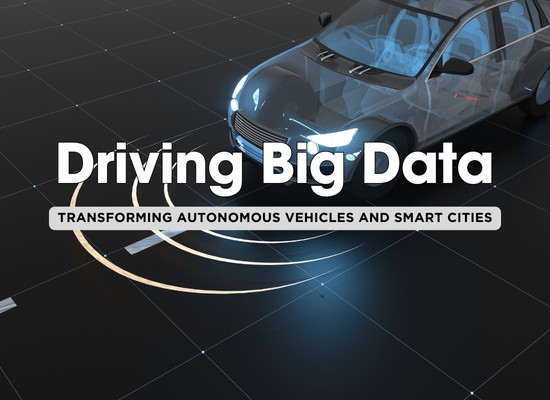Autonomous vehicles (AVs) are no longer a futuristic dream—they’re becoming a reality on our roads. Behind the scenes of this revolution lies an incredible driving force: big data. Every decision an AV makes, from braking to lane changes, relies on the constant analysis of massive amounts of data collected in real time. This data powers everything from navigation to obstacle detection, ensuring that self-driving cars can operate safely and efficiently. Let’s explore how big data drives autonomous vehicle decision-making and revolutionizes the way we think about transportation.
Data Collection – The Backbone of Autonomy

Autonomous vehicles are equipped with an array of sensors and technologies that gather immense volumes of data. Key data sources include:
- LIDAR and Radar: Generate 3D maps of the car’s surroundings, identifying obstacles and distances.
- Cameras: Capture real-time visual data to interpret traffic signals, road signs, and lane markings.
- GPS and Mapping Systems: Provide location data and navigation support.
- Internal Vehicle Sensors: Monitor speed, acceleration, and mechanical functions to ensure optimal performance.
How Does Data Collection Work?
- Continuous Input: Sensors operate in real time, constantly feeding information to the vehicle’s onboard system.
- Integration: Data from multiple sources is merged to create a comprehensive view of the vehicle’s environment.
- High-Frequency Updates: Systems refresh data up to several times per second to reflect dynamic road conditions.
Challenges in Data Collection
- Volume: A single AV generates terabytes of data daily, requiring efficient storage and processing.
- Accuracy: Sensors must provide precise data to prevent errors, especially in high-stakes situations like pedestrian detection.
- Environmental Factors: Weather conditions, like fog or rain, can interfere with sensor performance, complicating data collection.

Tesla’s Autopilot system collects data from over a million vehicles globally. This data feeds into a central system to refine algorithms, making Tesla’s vehicles smarter with every mile driven.
Data Processing – From Raw Input to Smart Decisions
Collecting data is just the first step. The true magic happens when this raw data is processed and analyzed to enable real-time decision-making. Autonomous vehicles must quickly interpret complex datasets to make split-second decisions, such as avoiding obstacles or responding to changing traffic conditions. Let’s dive into how this processing works and the technology that makes it possible.
How Autonomous Vehicles Process Data
- Preprocessing
- Raw data from sensors is cleaned and structured for analysis.
- Noise, such as irrelevant background data, is filtered out.
- Data Fusion
- Information from different sensors (e.g., LIDAR, cameras, GPS) is combined to create a unified understanding of the vehicle’s environment.
- This step ensures the AV can handle redundancies or fill gaps in individual sensor data.
- Machine Learning Models
- AI algorithms analyze the fused data to identify patterns and predict outcomes.
- For example, machine learning helps classify objects like pedestrians, vehicles, and road signs.
- Real-Time Decision Engines
- These engines use processed data to make immediate decisions, such as braking, accelerating, or changing lanes.
Checklist: Key Requirements for Effective Data Processing





Challenges in Data Processing

Processing terabytes of data in real time requires immense computational power, often necessitating custom-built hardware and software.

As AVs become more widespread, scaling processing systems to handle millions of vehicles globally is a significant hurdle.

Machine learning models must be trained to handle rare but critical events, like an animal crossing a highway or sudden weather changes.

Waymo’s autonomous vehicles use advanced AI processors capable of analyzing data from sensors in under a millisecond, enabling precise decision-making in dynamic environments.
Learning and Adaptation – Smarter Vehicles Over Time
One of the most remarkable aspects of autonomous vehicles (AVs) is their ability to learn and adapt. Through machine learning and big data analytics, AVs can improve their performance over time by analyzing past experiences. This process enables them to better handle rare scenarios, improve safety, and become more efficient. Here’s how learning and adaptation transform autonomous vehicle technology.
How AVs Learn from Big Data
- Data Aggregation
- Data collected from individual vehicles is uploaded to a central system (often via cloud platforms).
- This aggregated data provides insights into driving patterns, environmental challenges, and unusual events.
- Machine Learning Training
- AI models are continuously updated using aggregated data to improve object recognition, path planning, and decision-making.
- Training focuses on rare edge cases, such as construction zones or erratic pedestrian behavior.
- Updates and Deployment
- Updated AI models are sent back to vehicles, ensuring the fleet benefits from collective learning.
- Vehicles adapt to new environments without requiring individual reprogramming.
Real-Time Adaptation

AVs can adjust their navigation strategies based on real-time traffic data, optimizing routes and reducing delays.

Through continuous learning, AVs refine their ability to handle adverse conditions like heavy rain, fog, or snow.

Tesla’s fleet learning system collects data from millions of miles driven by its vehicles. This data trains its AI to navigate complex environments, making each new update smarter and more efficient.
Checklist: Key Benefits of Learning and Adaptation




Challenges in Learning and Adaptation



Shaping the Future of Autonomous Vehicle Ecosystems
Big data is not only transforming how autonomous vehicles (AVs) operate but also shaping the broader ecosystem in which they function. From regulatory frameworks to seamless integration with smart cities, big data is paving the way for a future where AVs are a staple of everyday life. Let’s explore how big data is driving this transformation.
1. Regulation and Safety Standards

As AV technology evolves, big data is critical in shaping safety regulations and standards. Data from AVs provides lawmakers and regulators with insights to create rules that enhance safety and public trust.

- Crash Analysis: Identifies patterns in accidents involving AVs, helping regulators establish safety benchmarks.
- Performance Metrics: Tracks how AVs handle specific scenarios, such as merging lanes or pedestrian crossings.
- Compliance Monitoring: Ensures AVs meet regulatory requirements, like maintaining safe distances or obeying speed limits.

The National Highway Traffic Safety Administration (NHTSA) uses big data from AV tests to create guidelines for autonomous vehicle operations on public roads.
2. Integration with Smart Cities

Big data allows AVs to communicate with smart city infrastructure, creating a seamless and efficient urban mobility system.

- Traffic Optimization: AVs share data with traffic lights and other vehicles to reduce congestion.
- Parking Solutions: Real-time data directs AVs to available parking spaces, minimizing idle driving.
- Energy Efficiency: Collaborates with smart grids to optimize charging schedules for electric AVs.

Cities like Singapore are testing AVs that communicate with traffic systems to reduce congestion and improve pedestrian safety.
3. Fleet Management and Logistics

Big data is revolutionizing the logistics and transportation industry by enabling AV fleets to operate with precision and efficiency.

- Predictive Maintenance: Monitors vehicle health and predicts when repairs are needed, reducing downtime.
- Route Optimization: Uses real-time data to plan the fastest, most fuel-efficient routes.
- Demand Forecasting: Predicts transportation needs to deploy AVs where they’re most needed.

Companies like Amazon are exploring AV delivery fleets that use big data for optimized logistics, reducing costs and delivery times.
4. Public Adoption and Trust

For AVs to succeed, public trust is essential. Big data helps build this trust by providing transparency and measurable improvements in safety and convenience.

- Transparent Reporting: Shares performance and safety data with the public to highlight reliability.
- User Feedback Integration: Uses data from early adopters to refine user experience.
- Education Campaigns: Provides insights to design effective campaigns that address public concerns.

Waymo publishes detailed safety reports based on data from its AV operations, building confidence among potential riders and stakeholders.
Big data is the engine behind the autonomous vehicle revolution. From enhancing real-time decision-making to shaping regulations and integrating with smart cities, its influence is profound and far-reaching.

- Big data enables AVs to learn, adapt, and improve over time.
- The integration of AVs with smart cities and logistics systems promises a more efficient future.
- Transparency and trust-building through big data are crucial for widespread public adoption.
As big data continues to advance, autonomous vehicles will not only redefine transportation but also revolutionize how we interact with our cities and the environment. The road ahead is exciting, and big data is lighting the way.





